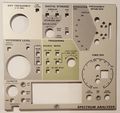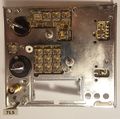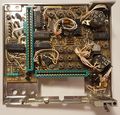7L5/Repairs
Intermittent Rotary Encoder
The "Dot Frequency" and "Reference Level" rotary encoders can become faulty to the point that they either do not work at all, or just cause random unpredictable changes when operated. The good news is that they are mechanical switches constructed from hard gold contact traces on the front panel PCB, and all elements are held together by screws. They can be accessed by separating the front panel from the 7L5 and removing the front panel overlay. Simply cleaning the gold traces on the PCBs with isopropyl alcohol and carefully bending the contact fingers slightly outward to reestablish contact force will restore operation. See the figures below.
Use caution: in at least some units, the three studs holding the switch sandwich together are plastic and will break if overtightened.
Front Panel Disassembly
The 7L5 is constructed of two main modules and the front panel assembly. The left module hinges outwards once a few screws are removed, and with further screw removal the complete front panel assembly comes off. When further disassembling the front panel, note the unconventional "Frequency Span" and "Time/Div" switches that need to be removed to be able to lift off the front panel overlay. These are entirely built into the particular knobs and can be pulled off from the front panel as a complete unit after removing two fasteners at the back. Note that the "Time/Div" switch has very thin metal contact fingers that fit into a socket at the front panel PCB. To guide installation, there is a little plastic spacer with conical holes for those pins. Make sure to install this spacer in the right orientation before attempting to reinstall the "Time/Div" switch, as shown in the figures.
Input Module Interface
A shorted capacitor in my L3 input module caused a resistor to overheat on A2000A2A2. To reach this, it's necessary to desolder ground connections between A2000A2 and the plugin housing, then to desolder the decoupling board A2000A2A1. The resistors were 5%, but many had drifted 20% or more, so I replaced all of them on both boards. In this process, I noticed a bent pin connecting A2000A2 and A2000A1. The socket on the former wasn't completely soldered down so I fixed it. I did not straighten the pin; it appears necessary for it to be bent to align.
Pictures
Front Panel
-
Front panel Overlay (Military version without B-(save A) )
-
Front panel with overlay removed in frame
-
Front panel backside in frame
-
Front panel frontside
-
Front panel backside
-
Front panel backside with Reference Level switch partially disassembled
-
Front panel backside with Reference Level switch removed. Parts of switch with sliding contacts shown below.
-
Front panel frontside with Reference Level switch removed. Switch gold contact traces visible
-
Span and Time/Div. switch backsides
-
Span and Time/Div. switch sideview
-
Front panel with Time/Div. switch removed. Note plastic spacer on the right
-
Front panel plastic spacer for Time/Div. switch installed in correct orientation, ready for switch installation.
Left Module
Right Module
Input module interface
-
-
-
note the bent pin to the left; apparently this is no accident




















